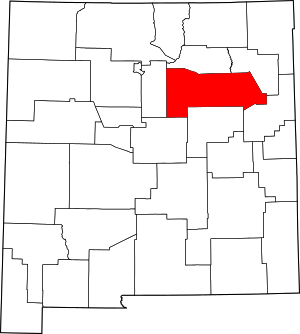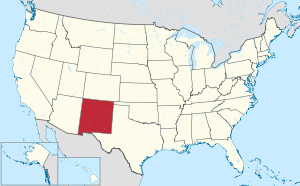San Miguel County, New Mexico
San Miguel County is a county in the U.S. state of New Mexico. As of the 2010 census, the population was 29,393.[1] Its county seat is Las Vegas.[2]
San Miguel County | |
|---|---|
 San Miguel County Courthouse in Las Vegas | |
 Location within the U.S. state of New Mexico | |
 New Mexico's location within the U.S. | |
| Coordinates: 35°28′N 104°50′W | |
| Country | |
| State | |
| Founded | January 9, 1852 |
| Named for | San Miguel del Vado |
| Seat | Las Vegas |
| Largest city | Las Vegas |
| Area | |
| • Total | 4,736 sq mi (12,270 km2) |
| • Land | 4,716 sq mi (12,210 km2) |
| • Water | 20 sq mi (50 km2) 0.4%% |
| Population | |
| • Estimate (2019) | 27,277 |
| • Density | 6.2/sq mi (2.4/km2) |
| Time zone | UTC−7 (Mountain) |
| • Summer (DST) | UTC−6 (MDT) |
| Congressional district | 3rd |
| Website | co |
San Miguel County comprises the Las Vegas, NM Micropolitan Statistical Area, which is also included in the Albuquerque-Santa Fe-Las Vegas, NM Combined Statistical Area.
Geography
According to the U.S. Census Bureau, the county has a total area of 4,736 square miles (12,270 km2), of which 4,716 square miles (12,210 km2) is land and 20 square miles (52 km2) (0.4%) is water.[3]
Adjacent counties
- Mora County - north
- Harding County - east
- Quay County - southeast
- Guadalupe County - south
- Torrance County - southwest
- Santa Fe County - west
National protected areas
Demographics
| Historical population | |||
|---|---|---|---|
| Census | Pop. | %± | |
| 1910 | 22,930 | — | |
| 1920 | 22,867 | −0.3% | |
| 1930 | 23,636 | 3.4% | |
| 1940 | 27,910 | 18.1% | |
| 1950 | 26,512 | −5.0% | |
| 1960 | 23,468 | −11.5% | |
| 1970 | 21,951 | −6.5% | |
| 1980 | 22,751 | 3.6% | |
| 1990 | 25,743 | 13.2% | |
| 2000 | 30,126 | 17.0% | |
| 2010 | 29,393 | −2.4% | |
| Est. 2019 | 27,277 | [4] | −7.2% |
| U.S. Decennial Census[5] 1790-1960[6] 1900-1990[7] 1990-2000[8] 2010-2016[1] | |||
2000 census
As of the 2000 census,[9] there were 30,126 people, 11,134 households, and 7,537 families living in the county. The population density was 6 people per square mile (2/km²). There were 14,254 housing units at an average density of 3 per square mile (1/km²). The racial makeup of the county was 56.22% White, 0.78% Black or African American, 1.82% Native American, 0.54% Asian, 0.08% Pacific Islander, 36.21% from other races, and 4.33% from two or more races. 77.96% of the population were Hispanic or Latino of any race.
There were 11,134 households out of which 34.60% had children under the age of 18 living with them, 44.50% were married couples living together, 16.40% had a female householder with no husband present, and 32.30% were non-families. 26.60% of all households were made up of individuals and 8.20% had someone living alone who was 65 years of age or older. The average household size was 2.58 and the average family size was 3.10.
In the county, the population was spread out with 27.40% under the age of 18, 10.90% from 18 to 24, 27.00% from 25 to 44, 22.90% from 45 to 64, and 11.70% who were 65 years of age or older. The median age was 35 years. For every 100 females there were 96.70 males. For every 100 females age 18 and over, there were 93.90 males.
The median income for a household in the county was $26,524, and the median income for a family was $31,250. Males had a median income of $27,307 versus $22,588 for females. The per capita income for the county was $13,268. About 19.90% of families and 24.40% of the population were below the poverty line, including 27.80% of those under age 18 and 25.90% of those age 65 or over.
2010 census
As of the 2010 census, there were 29,393 people, 11,978 households, and 7,275 families living in the county.[10] The population density was 6.2 inhabitants per square mile (2.4/km2). There were 15,595 housing units at an average density of 3.3 per square mile (1.3/km2).[11] The racial makeup of the county was 66.6% white, 1.7% American Indian, 1.4% black or African American, 0.8% Asian, 0.1% Pacific islander, 25.4% from other races, and 3.9% from two or more races. Those of Hispanic or Latino origin made up 76.8% of the population.[10] In terms of ancestry, 6.3% were German, 5.3% were English, and 1.6% were American.[12]
Of the 11,978 households, 28.8% had children under the age of 18 living with them, 38.6% were married couples living together, 14.9% had a female householder with no husband present, 39.3% were non-families, and 32.5% of all households were made up of individuals. The average household size was 2.34 and the average family size was 2.95. The median age was 40.7 years.[10]
The median income for a household in the county was $32,213 and the median income for a family was $42,888. Males had a median income of $35,176 versus $28,351 for females. The per capita income for the county was $18,508. About 15.7% of families and 24.8% of the population were below the poverty line, including 29.6% of those under age 18 and 22.7% of those age 65 or over.[13]
Communities
City
- Las Vegas (county seat)
Villages
Census-designated places
Other communities
- Bernal
- El Porvenir
- Garita
- Holy Ghost
- Ilfeld
- Montezuma
- Rociada
- San Miguel del Vado
- Sapello
- Serafina
- South San Ysidro
- Tererro
- Trementina
- Valles de San Geronimo
Ghost town
Notable people
- Antonia Apodaca (1923–) born in Rociada, folk musician and composer
- Margaret Larkin (1899–1967), born in Las Vegas, writer and musician
Politics
San Miguel County is heavily Democratic. The last time it voted Republican for president was 1956, and since 1992 no Republican has cracked 30% of the vote.
| Year | Republican | Democratic | Third parties |
|---|---|---|---|
| 2016 | 21.5% 2,313 | 67.8% 7,285 | 10.7% 1,153 |
| 2012 | 20.0% 2,303 | 76.9% 8,850 | 3.1% 356 |
| 2008 | 19.2% 2,478 | 79.8% 10,320 | 1.1% 143 |
| 2004 | 27.3% 3,313 | 71.7% 8,683 | 1.0% 120 |
| 2000 | 24.2% 2,215 | 71.4% 6,540 | 4.4% 406 |
| 1996 | 20.1% 1,938 | 72.5% 6,995 | 7.4% 714 |
| 1992 | 23.3% 2,183 | 65.9% 6,186 | 10.8% 1,018 |
| 1988 | 30.6% 2,763 | 68.0% 6,131 | 1.4% 129 |
| 1984 | 39.4% 3,485 | 59.1% 5,227 | 1.6% 138 |
| 1980 | 39.3% 3,292 | 53.9% 4,514 | 6.7% 563 |
| 1976 | 37.2% 3,162 | 61.2% 5,204 | 1.7% 141 |
| 1972 | 47.7% 4,434 | 50.2% 4,663 | 2.1% 196 |
| 1968 | 48.1% 4,027 | 48.9% 4,088 | 3.0% 253 |
| 1964 | 31.9% 2,714 | 67.8% 5,767 | 0.3% 24 |
| 1960 | 41.9% 3,988 | 58.0% 5,520 | 0.1% 6 |
| 1956 | 55.9% 5,083 | 44.1% 4,014 | 0.0% 3 |
| 1952 | 54.6% 5,360 | 45.3% 4,451 | 0.1% 7 |
| 1948 | 48.3% 4,655 | 51.4% 4,953 | 0.2% 21 |
| 1944 | 46.1% 4,014 | 53.8% 4,684 | 0.1% 4 |
| 1940 | 44.6% 4,882 | 55.3% 6,054 | 0.1% 7 |
| 1936 | 43.1% 4,697 | 56.8% 6,199 | 0.1% 10 |
| 1932 | 51.3% 5,364 | 48.5% 5,076 | 0.2% 20 |
| 1928 | 59.3% 5,184 | 40.7% 3,560 | 0.1% 4 |
| 1924 | 50.6% 3,894 | 46.0% 3,543 | 3.4% 265 |
| 1920 | 58.1% 5,535 | 41.9% 3,990 | |
| 1916 | 56.4% 2,932 | 42.9% 2,231 | 0.7% 38 |
| 1912 | 55.7% 2,479 | 39.1% 1,740 | 5.3% 234 |
See also
References
- "State & County QuickFacts". United States Census Bureau. Retrieved September 30, 2013.
- "Find a County". National Association of Counties. Retrieved June 7, 2011.
- "2010 Census Gazetteer Files". United States Census Bureau. August 22, 2012. Archived from the original on January 1, 2015. Retrieved January 2, 2015.
- "Population and Housing Unit Estimates". Retrieved December 23, 2019.
- "U.S. Decennial Census". United States Census Bureau. Retrieved January 2, 2015.
- "Historical Census Browser". University of Virginia Library. Retrieved January 2, 2015.
- "Population of Counties by Decennial Census: 1900 to 1990". United States Census Bureau. Retrieved January 2, 2015.
- "Census 2000 PHC-T-4. Ranking Tables for Counties: 1990 and 2000" (PDF). United States Census Bureau. Retrieved January 2, 2015.
- "U.S. Census website". United States Census Bureau. Retrieved January 31, 2008.
- "DP-1 Profile of General Population and Housing Characteristics: 2010 Demographic Profile Data". United States Census Bureau. Archived from the original on February 13, 2020. Retrieved January 24, 2016.
- "Population, Housing Units, Area, and Density: 2010 - County". United States Census Bureau. Archived from the original on February 13, 2020. Retrieved January 24, 2016.
- "DP02 SELECTED SOCIAL CHARACTERISTICS IN THE UNITED STATES – 2006-2010 American Community Survey 5-Year Estimates". United States Census Bureau. Archived from the original on February 13, 2020. Retrieved January 24, 2016.
- "DP03 SELECTED ECONOMIC CHARACTERISTICS – 2006-2010 American Community Survey 5-Year Estimates". United States Census Bureau. Archived from the original on February 13, 2020. Retrieved January 24, 2016.
- Leip, David. "Dave Leip's Atlas of U.S. Presidential Elections". uselectionatlas.org. Retrieved April 2, 2018.
External links
| Wikimedia Commons has media related to San Miguel County, New Mexico. |
